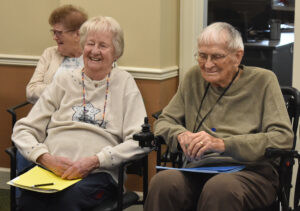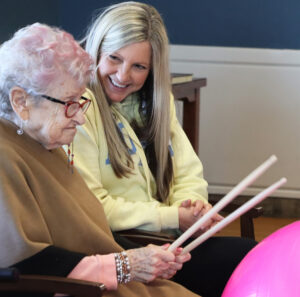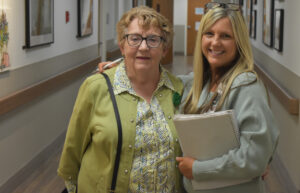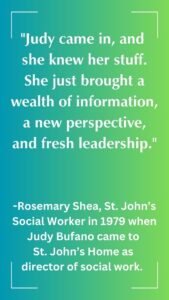Three Social Workers
These three geriatric social workers—two retired and one working in long-term care—discuss their profession for National Social Work Month.
Bizza Milliken was a nun teaching catholic school when she was offered the opportunity to study for a graduate degree in social work at Boston College.

“I was a member of the Sisters of Mercy at the time,” says Bizza. It was the late 1960s in Rochester, New York and it had been decided that nuns who were “serving the poor, sick, and uneducated” out in the community needed more professional training. Or, as Bizza puts it: “Do-gooders often did more harm than good. They thought we needed some kind of experience in social work in order to . . . not create a system of greater dependency.”
Bizza was also a case manager at the time and admits “I must have shown promise.” In addition to her employer encouraging her pursuit of a Masters in Social Work, she was rewarded with an internship between semesters that changed the trajectory of her career. “The summer in between my graduate school years, Catholic Family Center had established a two-person pair—a nurse and a social worker—who did placement for nursing homes.” Speaking from her St. John’s Meadows apartment, Bizza shared, “I learned a lot from them about working with older people and also the whole system.”
A Nurse and a Social Worker
Judy Bufano was a visiting nurse for 10 years before pursuing her first degree in social work.
Judy says that when she expressed interest in joining the inaugural social work class at SUNY Brockport, a state school just northwest of Rochester near Lake Ontario, her future professors were thrilled. “They said ‘you’re a public health nurse? Yes, come right over,’” remembers Judy.
Her decade of health care experience as well as her perspectives on the systems that many of her classmates would soon need to navigate professionally, positioned Judy attractively to the PhD level instructors at Brockport when they launched the program.
Judy earned her undergraduate in social work in 1973, followed by a Master’s Degree from Syracuse University. What Judy calls “that dual background” of nursing and social work served her well throughout her career, particularly during her 20 years as the director of social work at Rochester nursing home St. John’s Home.
Following a Familiar Path
Michelle Killeen was a recent high school graduate when she enrolled in social work school.
Like Judy Bufano, Michelle earned her undergraduate degree at SUNY Brockport (class of 1996).

Like Bizza Milliken, Michelle references a graduate school internship she had with Catholic Family Center supporting older adults as being influential to her.
Growing up in Hilton, New York, Michelle says she was lucky to have her grandparents living within 50 miles of her. She has great memories of spending school vacations at their house and travelling together to her grandfather’s bowling tournaments. It was no big surprise to Michelle when a concentration in geriatric social work felt more natural than other paths.
“I never thought it would be in a nursing home, though,” says Michelle. “Back when you’re in junior high, high school, and college, you picture nursing homes like what you see in the news. You don’t realize the life they (residents) still have.”
Michelle has been a working long-term care social worker in Rochester since the late 1990s. She came to St. John’s Home this past summer after working at a for-profit nursing home.
A Different Way of Doing Things
“We go for the warm fuzzies. You have to—you’re a non-profit. What else are you supposed to do with the money?”
Judy Bufano cannot help using “we” when referring to St. John’s, even though it has been close to 20 years since she last worked for St. John’s Meadows as an elder advocate, following her retirement from St. John’s Home.
In the early 2000s, when asked to do some consulting for a for-profit nursing home, Judy had a straight-forward response to the offer. “I told them ‘You don’t want me. I’m going to want all of the warm and fuzzy stuff, and you’re not going to want to do it.’”
Judy Bufano and Michelle Killeen—geriatric social workers from different eras who received their undergraduate degree from the same school—met for the first time earlier this month on St. Patrick’s Day. It had been a few years since Judy last walked the halls of St. John’s Home. While she admired the ground floor renovations with vintage history postcards and photos of local landmarks hung on the walls throughout, Judy was most interested in hearing from Michelle.
Judy was surprised to learn of Michelle’s current caseload; although Michelle explained how that number of residents for which she is considered the primary social worker will soon be reduced when a new person joins the team next month.
Michelle asked Judy, “What was the typical number for a case load when you were here?”
“Oh, we would have maybe two floors,” said Judy. “Sometimes we would (also) split a floor.”
The two compared notes on guiding not-for-profit nursing home social work teams and found commonalities across their respective eras. Michelle explained how a lot of her time recently had been spent finishing state assessments for memory and mood. “We ask questions to see if they’re feeling down or depressed,” she explains. “Every resident has one done quarterly.”
Judy could relate to the plethora of paperwork, although one major difference between her era and Michelle’s is glaring to Judy. “We all had time back then,” she says, referencing an interdisciplinary team Judy led that discussed the more complex referrals—sometimes taking multiple days to come to a consensus.
“There just isn’t the time to do that anymore,” says Michelle, who also served as admissions director in her previous role prior to St. John’s.

While she agrees that time is of the essence in much of what they do, Michelle is still able to strike a better work/life balance working in a non-profit setting. “Before I was working 10-hour days at work and spending two hours a night at home documenting and trying to catch up. (Now) I can do actual social work and feel like I’m making a difference.”
Social Work: An Art and a Science
When Bizza Milliken enrolled at Boston College, one of her professors was Dr. Mary Ella Robertson, a pioneer in the field of social work who would soon become the first woman and first person of color named to the board of directors at John Hancock. Bizza says Dr. Robertson called social work “an art and a science.” That is an apt description when you consider that some undergraduate social work programs give a Bachelor of Arts upon graduation, while others award a Bachelor of Science (it depends on the school).
Bizza returned to Rochester following school and became director of social work at Highland Hospital in 1971. “I organized the department—it was not an organized social work department at the time,” she explains. “It happened on the heels of the state demanding that every hospital have a Masters-level social worker.”
1971 was also the year Bizza left the convent. “There were a lot of changes coming, and what my concept of community life was—doing things together and being part of one organization, so to speak—was different,” she says.
Bizza says she learned that the art of social work is in your own ability to build interpersonal relationships. “Do you care about people? How are you able to be empathetic while also building a professional ability to do the job?”
“The science part is the information you gain,” she says, “so that you have good information to draw on.”
Professional Teams on Either Side of the Park
Highland Hospital and St. John’s Home are separated by a half mile stretch of South Avenue, unless you choose to cut across the rolling hills of the northern part of Rochester’s Highland Park.
Bizza and her team were responsible for discharge planning from the hospital to nursing homes like St. John’s. “In the seventies it was so bad, there were whole floors in hospitals, because there was such a backup of patients either waiting to go back to their nursing home or new patients waiting to be admitted. It was really tough.”
This issue of hospital backups and too few nursing home beds still rings true for geriatric social workers today; although maybe there is hope for a turnaround if history is as a guide.
As Bizza explains it, “the whole nursing home thing dramatically changed in the late sixties and the seventies. Before, there wasn’t anything formalized, we didn’t have professional-type nursing homes until places like St. John’s began to pull it into more of a system.”
Bizza’s and Judy’s teams collaborated together for years until Bizza left Highland Hospital in 1988. “We worked really well together,” says Bizza of her working relationship with Judy. “There was a very close, cooperative relationship . . . not just with discharge planning. The nurses interacted with patients going between Highland to St. John’s and then there were people from St. John’s who were admitted to Highland.”
Where Do Social Workers Go When They Retire?
 Judy Bufano moved to independent living last spring—a bungalow at Brickstone by St. John’s located at the south end of Highland Park. On her first day there, Judy went to lunch next door at sister community St. John’s Meadows and saw Bizza, who of course stopped by to visit. Bizza and her husband Jim have lived at St. John’s Meadows for over a decade now. Prior to that, they helped Jim’s sister navigate the St. John’s continuum of care after living at St. John’s Meadows for years.
Judy Bufano moved to independent living last spring—a bungalow at Brickstone by St. John’s located at the south end of Highland Park. On her first day there, Judy went to lunch next door at sister community St. John’s Meadows and saw Bizza, who of course stopped by to visit. Bizza and her husband Jim have lived at St. John’s Meadows for over a decade now. Prior to that, they helped Jim’s sister navigate the St. John’s continuum of care after living at St. John’s Meadows for years.
Judy took the opportunity to remind Bizza about their first interaction on the job once Judy started at St. John’s Home in 1979. “I said ‘Bizza, you called me into your office at Highland and you straightened me out about what I needed to do.’”
“And you were right,” Judy told Bizza, with a smile.
“When Judy came (to St. John’s Home), things did change,” says Bizza, looking back. “The professional relationships that were developed made the work a lot easier.”
Bizza, Judy, and Michelle: Three Masters-trained social workers who became well-versed in the art and the science of their chosen profession.
